You are using an out of date browser. It may not display this or other websites correctly.
You should upgrade or use an alternative browser.
You should upgrade or use an alternative browser.
C3 Howitzer Replacement
- Thread starter MattGotts
- Start date
FJAG
Army.ca Legend
- Reaction score
- 11,385
- Points
- 1,160
I've recently learned that we still have some in hand. Not sure how many. I've heard 6 and seen photos of 4. There may be more for all that I know.It's a shame ours were sold off, although as I understand it, they weren't used correctly.
- Reaction score
- 16,934
- Points
- 1,260
In what sort of shape?I've recently learned that we still have some in hand. Not sure how many. I've heard 6 and seen photos of 4. There may be more for all that I know.

The E Bty ones at the end were pretty rough, and F Bty had already gone to C1’s due to lack of spares as I had understood it.
FJAG
Army.ca Legend
- Reaction score
- 11,385
- Points
- 1,160
About all that I know is that those in Pet were brought into shape, at least for salute firing purposes, for the 100th Vimy celebration.In what sort of shape?
The E Bty ones at the end were pretty rough, and F Bty had already gone to C1’s due to lack of spares as I had understood it.
Just to carry on with the Chilean Army, they originally bought 59 L5s and also had 190 older M101 howitzers (the equivalent of our C1). 136 of their M101s were upgraded to M101/33s with kits from RDM, the same Dutch company that did our C3 conversion. They still seem to be in service with some of their motorized units. As far as I can tell only Canada and Chile did these upgrades. No idea if the Chileans have the same issues as us but my guess is they would if the conversion kits are the same.
Short Chilean video of draftees learning to bring the M101/33 into action.
Interestingly, the Chileans seem to be able to manage four types of systems in relatively low numbers while we have trouble with three. Article on their guns below. It's Spanish but just hit Google translate on your browser.
GR66
Army.ca Veteran
- Reaction score
- 3,341
- Points
- 1,160
Where for example would a CRV7 equipped vehicle fit in a Canadian ORBAT? With only around a 4km range you wouldn't want it in the direct support artillery regiment. In the Battalion CS Company? Are light rockets then an Infantry support weapon? Are you not better off with mortars that can provide some sustained fire rather than a volley? Or if you're looking for a precision weapon something more like a laser-guided ATGM or a loitering munition?Meanwhile - in the shoot and scoot environment in which the Ukrainians find themselves
Pickup trucks mounting 57mm, 70mm, 80mm and 120mm rockets in expedient mounts.
Fire a couple of missiles, adjust, unload on target, get out of dodge while other units repeat the mission.
The Ready To Fire Missile, launched direct from the limber with no need for a complicated gun seems to becoming a favourite with everybody from Territorial ATGM gunners, through MANPADS and Air Def operators to the Artillery.
Consummables on the guns - charges, shells, driving bands, lands, breech blocks, recuperators
Launch requirements for missiles

Especially true of guided missiles that can be fired off-bore.
These systems seem to make much more sense for the Ukrainian Territorial Battalions where you have a relatively fixed line of contact but they don't seem like the right weapon system for an expeditionary mobile force like Canada needs.
MilEME09
Army.ca Veteran
- Reaction score
- 2,366
- Points
- 1,210
CRV7 had a Laser guided PG varient, if we wanted a proper ground launched version the rockets would need to get beefed up a bit to extend range but it would be done.Where for example would a CRV7 equipped vehicle fit in a Canadian ORBAT? With only around a 4km range you wouldn't want it in the direct support artillery regiment. In the Battalion CS Company? Are light rockets then an Infantry support weapon? Are you not better off with mortars that can provide some sustained fire rather than a volley? Or if you're looking for a precision weapon something more like a laser-guided ATGM or a loitering munition?
These systems seem to make much more sense for the Ukrainian Territorial Battalions where you have a relatively fixed line of contact but they don't seem like the right weapon system for an expeditionary mobile force like Canada needs.
- Reaction score
- 16,934
- Points
- 1,260
Spike NLOS-ER and Javelin offer a better option for that role.CRV7 had a Laser guided PG varient, if we wanted a proper ground launched version the rockets would need to get beefed up a bit to extend range but it would be done.
No one wants to sit and designate a target for something like that.
If you’re going to designate a target you want to have a big payload inbound.
Colin Parkinson
Army.ca Myth
- Reaction score
- 9,222
- Points
- 1,160
Actually 6 types when you count their AD. Hopefully we don't have to fight them as seem to be "Near peer" army to them.About all that I know is that those in Pet were brought into shape, at least for salute firing purposes, for the 100th Vimy celebration.
Just to carry on with the Chilean Army, they originally bought 59 L5s and also had 190 older M101 howitzers (the equivalent of our C1). 136 of their M101s were upgraded to M101/33s with kits from RDM, the same Dutch company that did our C3 conversion. They still seem to be in service with some of their motorized units. As far as I can tell only Canada and Chile did these upgrades. No idea if the Chileans have the same issues as us but my guess is they would if the conversion kits are the same.
Short Chilean video of draftees learning to bring the M101/33 into action.
Interestingly, the Chileans seem to be able to manage four types of systems in relatively low numbers while we have trouble with three. Article on their guns below. It's Spanish but just hit Google translate on your browser.

- Reaction score
- 7,347
- Points
- 1,160
Where for example would a CRV7 equipped vehicle fit in a Canadian ORBAT? With only around a 4km range you wouldn't want it in the direct support artillery regiment. In the Battalion CS Company? Are light rockets then an Infantry support weapon? Are you not better off with mortars that can provide some sustained fire rather than a volley? Or if you're looking for a precision weapon something more like a laser-guided ATGM or a loitering munition?
These systems seem to make much more sense for the Ukrainian Territorial Battalions where you have a relatively fixed line of contact but they don't seem like the right weapon system for an expeditionary mobile force like Canada needs.
Lets back this up a bit.
The 70 mm rocket started life in the 1940s as an Air to Air rocket.
the Luftwaffe had shown that volleys of their Werfer-Granate 21 rockets, first used by elements of the Luftwaffe's JG 1 and JG 11 fighter wings on July 29, 1943, against USAAF bombers attacking Kiel and Warnemünde, could be a potent air-to-air weapon.
The Mk 4 Folding-Fin Aerial Rocket (FFAR), also known as "Mighty Mouse", was an unguided rocket used by United States military aircraft. It was 2.75 inches (70 mm) in diameter. Designed as an air-to-air weapon for interceptor aircraft to shoot down enemy bombers,....
FFARs were the primary armament of many NATO interceptor aircraft in the early 1950s, including the F-86D, F-89, F-94C, and the CF-100. They were also carried by the F-102 Delta Dagger to supplement its guided missile armament.
Worthwhile keeping that quote in mind as we go forwards here.The Mighty Mouse was to prove a poor aerial weapon. Although it was powerful enough to destroy a bomber with a single hit, its accuracy was abysmal. The rockets dispersed widely on launch: a volley of 24 rockets would cover an area the size of a football field. A particularly clear demonstration of this poor accuracy occurred on August 16, 1956, when a pair of U.S. Air Force F-89s were unable to shoot down a runaway U.S. Navy drone aircraft despite expending 208 rockets in the attempt.[6]
So the Hydra and the CRV-7 started life as crap air-to-air missiles that had some effect when used against massed bombers flying wing-tip to wing-tip in box formations in day light.
As a result, by the late 1950s it had been largely abandoned as an aircraft weapon in favor of the guided air-to-air missiles then becoming available.
But there was a new kid on the block - the armed helicopter - and the US Army was looking for close support now that it had lost its air force to Dr Strangelove.
A volley of FFARs was as devastating as a heavy cannon with far less weight and recoil, and in the ground-attack role its marginal long-range accuracy was less important.....(FFARs) could be fitted with different warheads depending on the mission...a wide variety of specialized warheads were developed for antipersonnel, antitank, and target-marking use
Note especially the wide variety of warheads.
They became quite popular in Vietnam
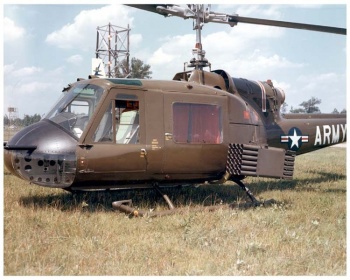
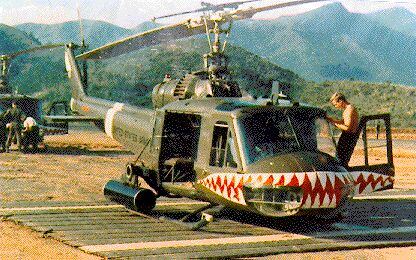
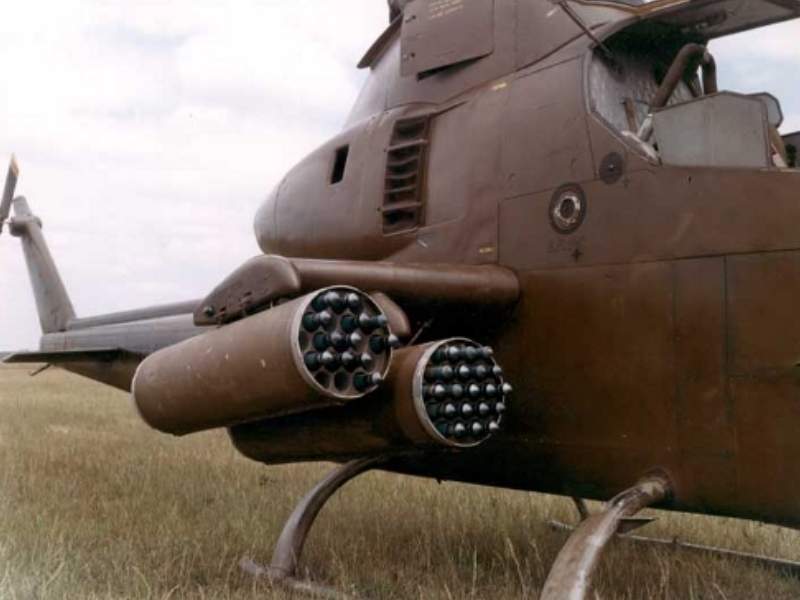
The HE versions were equivalent in punch to a 105mm round. A single Huey could launch a stonk equivalent to a battery of 105s firing 8 rounds for effect. An Air Cavalry commander's hip pocket artillery, useful for the mortar role when the mortar didn't make sense.
The system survived in the Air Land arsenal of the 1980s and made in into the inventory of the Apache and the Super Cobra. They were retained alongside the rise of the precision guided missiles like the TOWs and the Hellfires because they were useful and they were cheap.
The one thing they never overcame was their inaccuracy and with the COIN wars need to eliminate collateral damage and the rising demand for precision commanders found themselves using fewer 70s and more Hellfires.
But the Hellfires cost a fortune - more than 100 grand apiece. A bit of a hefty expense if you were plinking Mustapha in the back of a Hilux.
So the requirement was written for a cheaper Hellfire - and the solution was found mating a control package to a Hydra 70 that could utilize the full range of existing motors, warheads and launchers simply by screwing on a seeker module in the field like a fuse. They became really popular and the 70mm production lines (things now recognized to have strategic value) were kept open to supply what was now known as the APKWS or Advanced Precision Kill Weapon System.
In direct fire mode the 70mm rocket has a range of about 4 km. That is true. But in ballistic mode that range is extended to about 10 km (8 to 12). Of course in ballistic mode you give up some accuracy but 24 rounds of 105 (or even 81) in a football field is going to have an effect on the locals. And with the laser guidance the missile can be controlled from the launch site or a PLGR in the hands of a Forward Observer. The unit cost of the APKS is now about $20,000 compared to the current price of $150,000 for the Hellfire and Brimstone missiles.
The available warheads are
| Designation | Description | Weight | Payload | Fuze Type | Fuzing options |
|---|---|---|---|---|---|
| M151 | High explosive (HEDP) '10 pounder' | 8.7 pounds (3.9 kg) (w/o Fuze) | 2.3 pounds (1.0 kg) Comp B-4 HE | M423 | 1,2,5,7,8 |
| M156 | White phosphorus munitions (WP) | 9.65 pounds (4.38 kg) | 2.2 pounds (1.00 kg) WP | M423 M429 | 1,2,6,7 |
| M229 | High explosive (HEDP); elongated M151 '17 pounder' | 17.0 pounds (7.7 kg) (Fuzed) | 4.8 pounds (2.2 kg) Comp B-4 HE | M423 | 1,2,6,7 |
| M247 | High-explosive anti-tank (HEAT)/high-explosive dual purpose (HEDP) | 8.8 pounds (4.0 kg) | 2.0 pounds (0.91 kg) Comp B HE | M438 PD | 4 (integral to warhead) |
| M255 | APERS (anti-personnel) warhead | 2500 28 grains (1.8 g) flechettes | 9 | ||
| M255E1/A1 | Flechette warhead | 14.0 pounds (6.4 kg) | 1179 60 grains (3.9 g) flechettes | M439 | 9 |
| M257 | Parachute illumination | 11.0 pounds (5.0 kg) | One M257 Candle (Flare) 1 million candela | M442 | 10 (integral to warhead) |
| M259 | White phosphorus (WP) | 9 | |||
| M261 | Multi-purpose submunition (MPSM) | 13.5 pounds (6.1 kg) | 9 M73 (Grenade) Submunitions | M439 with M84 electric detonator | 9 |
| M264 | Red phosphorus (RP) Smoke | 8.6 pounds (3.9 kg) | 72 RP Pellets | M439 | 9 |
| M267 | MPSM Practice | 13.5 pounds (6.1 kg) | Three Marking SMs, 6 Metal Weights | M439 with M84 electric Detonator | 9 |
| M274 | Practice (Smoke) | 9.3 pounds (4.2 kg) | 2 ounces (57 g) of potassium perchlorate and aluminum powder | M423 | 1 |
| M278 | Infra-red (IR) parachute illumination | 11.0 pounds (5.0 kg) | One M278 IR Flare | M442 | 10 (integral to warhead) |
| M282 | Multipurpose penetrator warhead | 13.7 pounds (6.2 kg) | 0.98 pounds (0.44 kg) PBXN-110 | delayed | |
| Mk 67 Mod 0 | White phosphorus (WP) | 1,2,6,7 | |||
| Mk 67 Mod 1 | Red phosphorus (RP) | 1,2,6,7 | |||
| WTU-1/B | Practice | 9.3 pounds (4.2 kg) | Inert | None | None |
| WDU-4/A | APERS warhead | 9.3 pounds (4.2 kg) | 96 flechettes of unknown weight | 12 (integral to warhead) | |
| WDU-4A/A | APERS warhead | 9.3 pounds (4.2 kg) | 2205 20 grains (1.3 g) flechettes | 12 (integral to warhead) |
Broadly comparable to the selection available to a 105mm Battery and considerably more varied than the 81mm arsenal available.
Launch platforms range from aircraft and helicopters to towed mounts, to light trucks, to UAVs
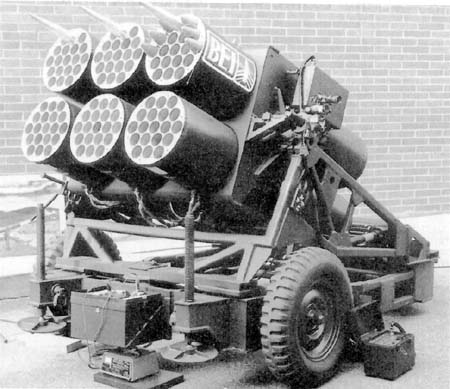
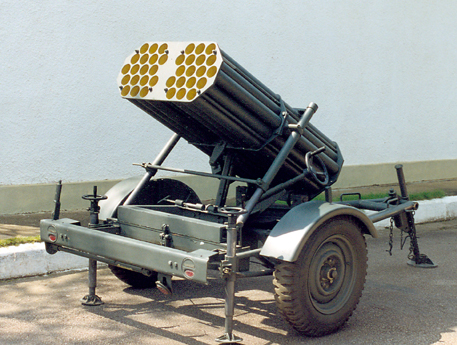



With the latest "hot" item being
L3Harris’ Vehicle-Agnostic Modular Palletized ISR Rocket Equipment (VAMPIRE) is a portable kit that can be installed on most vehicles with a cargo bed for launching of the advanced precision kill weapons system (APKWS) or other laser-guided munitions.
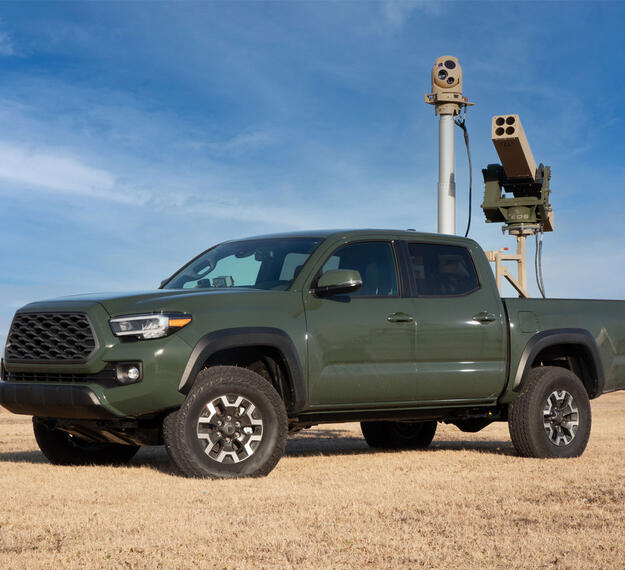
I could suggest that that pickup truck, with its laser designator, might not have to use its own missiles. It could just as easily paint a target for a bunch of APKWS rockets launched from a remote vehicle. Or the MQ8B could be used to paint targets.
Those targets could be light armoured vehicles, logistics vehicles, domestic structures, ships and, apparently, slow flying helicopters and drones. I would also not that the Stinger is a 70mm rocket as well but with a different guidance system.
What I am saying, in my usual convoluted fashion, is that the 70mm rocket system, is a low cost munition that is widely available, that has open production lines, that can be launched from a bunch of platforms, carry a bunch of effects, can be guided and fused in a bunch of different ways and can be employed, effectively, against a bunch of different targets.
And
It is an insensitive munition, that can be managed with minimal training by conscripts and doesn't require the upkeep of a C3 with its breech, barrel and recuperators.
Is it harder to aim and maintain than a mortar? I don't know but the mortars mounted on trucks are no longer as simple to operate as a 60mm handheld.
It is often argued that it takes more time to reload a rocket pod. But that assumes that you are going to launch all the rockets at once. But if you are using them with guidance, or even with UAS observation, then you don't need to unload the entire pod in one go. You can treat the pod as a limber with a range of ready to launch shots on board.
The other reason I like the rocket based system is the demonstrated value of shoot and scoot, fire and retire, operations in the current environment.
Also, logistically, I like the idea of being able to deliver Ready to Launch pods forwards to the launcher.
Finally - Infantry works on their feet, right enough, but even the Paras on the Falklands were appreciative of the internal combustion engine to move them about the country side - Airborne Initiative. When they came back they bought these things
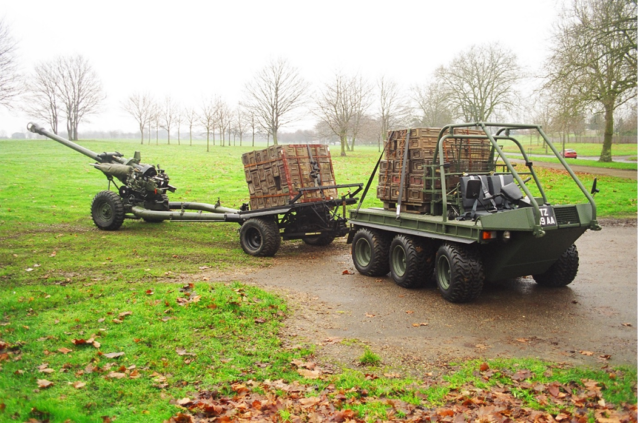
Which are now being turned into autonomous platforms that can be optionally manned.
So where would the 70mm rocket fit in the Canadian Arsenal? Light Infantry Weapons Coys, Light Cavalry Support Troops, AOPS UAVs and Helicopters, Griffons, Perhaps the MSHORADs as an alternative to the Hellfires? Artillery if the artillery is in the 10 km range band anymore?
- Reaction score
- 16,934
- Points
- 1,260
Lets back this up a bit.
The 70 mm rocket started life in the 1940s as an Air to Air rocket.
Worthwhile keeping that quote in mind as we go forwards here.
So the Hydra and the CRV-7 started life as crap air-to-air missiles that had some effect when used against massed bombers flying wing-tip to wing-tip in box formations in day light.
But there was a new kid on the block - the armed helicopter - and the US Army was looking for close support now that it had lost its air force to Dr Strangelove.
Note especially the wide variety of warheads.
They became quite popular in Vietnam



The HE versions were equivalent in punch to a 105mm round. A single Huey could launch a stonk equivalent to a battery of 105s firing 8 rounds for effect. An Air Cavalry commander's hip pocket artillery, useful for the mortar role when the mortar didn't make sense.
The system survived in the Air Land arsenal of the 1980s and made in into the inventory of the Apache and the Super Cobra. They were retained alongside the rise of the precision guided missiles like the TOWs and the Hellfires because they were useful and they were cheap.
The one thing they never overcame was their inaccuracy and with the COIN wars need to eliminate collateral damage and the rising demand for precision commanders found themselves using fewer 70s and more Hellfires.
But the Hellfires cost a fortune - more than 100 grand apiece. A bit of a hefty expense if you were plinking Mustapha in the back of a Hilux.
So the requirement was written for a cheaper Hellfire - and the solution was found mating a control package to a Hydra 70 that could utilize the full range of existing motors, warheads and launchers simply by screwing on a seeker module in the field like a fuse. They became really popular and the 70mm production lines (things now recognized to have strategic value) were kept open to supply what was now known as the APKWS or Advanced Precision Kill Weapon System.
In direct fire mode the 70mm rocket has a range of about 4 km. That is true. But in ballistic mode that range is extended to about 10 km (8 to 12). Of course in ballistic mode you give up some accuracy but 24 rounds of 105 (or even 81) in a football field is going to have an effect on the locals. And with the laser guidance the missile can be controlled from the launch site or a PLGR in the hands of a Forward Observer. The unit cost of the APKS is now about $20,000 compared to the current price of $150,000 for the Hellfire and Brimstone missiles.
The available warheads are
Designation Description Weight Payload Fuze Type Fuzing options M151 High explosive (HEDP) '10 pounder' 8.7 pounds (3.9 kg) (w/o Fuze) 2.3 pounds (1.0 kg) Comp B-4 HE M423 1,2,5,7,8 M156 White phosphorus munitions (WP) 9.65 pounds (4.38 kg) 2.2 pounds (1.00 kg) WP M423 M429 1,2,6,7 M229 High explosive (HEDP); elongated M151 '17 pounder' 17.0 pounds (7.7 kg) (Fuzed) 4.8 pounds (2.2 kg) Comp B-4 HE M423 1,2,6,7 M247 High-explosive anti-tank (HEAT)/high-explosive dual purpose (HEDP) 8.8 pounds (4.0 kg) 2.0 pounds (0.91 kg) Comp B HE M438 PD 4 (integral to warhead) M255 APERS (anti-personnel) warhead 2500 28 grains (1.8 g) flechettes 9 M255E1/A1 Flechette warhead 14.0 pounds (6.4 kg) 1179 60 grains (3.9 g) flechettes M439 9 M257 Parachute illumination 11.0 pounds (5.0 kg) One M257 Candle (Flare) 1 million candela M442 10 (integral to warhead) M259 White phosphorus (WP) 9 M261 Multi-purpose submunition (MPSM) 13.5 pounds (6.1 kg) 9 M73 (Grenade) Submunitions M439 with M84 electric detonator 9 M264 Red phosphorus (RP) Smoke 8.6 pounds (3.9 kg) 72 RP Pellets M439 9 M267 MPSM Practice 13.5 pounds (6.1 kg) Three Marking SMs, 6 Metal Weights M439 with M84 electric Detonator 9 M274 Practice (Smoke) 9.3 pounds (4.2 kg) 2 ounces (57 g) of potassium perchlorate and aluminum powder M423 1 M278 Infra-red (IR) parachute illumination 11.0 pounds (5.0 kg) One M278 IR Flare M442 10 (integral to warhead) M282 Multipurpose penetrator warhead 13.7 pounds (6.2 kg) 0.98 pounds (0.44 kg) PBXN-110 delayed Mk 67 Mod 0 White phosphorus (WP) 1,2,6,7 Mk 67 Mod 1 Red phosphorus (RP) 1,2,6,7 WTU-1/B Practice 9.3 pounds (4.2 kg) Inert None None WDU-4/A APERS warhead 9.3 pounds (4.2 kg) 96 flechettes of unknown weight 12 (integral to warhead) WDU-4A/A APERS warhead 9.3 pounds (4.2 kg) 2205 20 grains (1.3 g) flechettes 12 (integral to warhead)
Broadly comparable to the selection available to a 105mm Battery and considerably more varied than the 81mm arsenal available.
Launch platforms range from aircraft and helicopters to towed mounts, to light trucks, to UAVs





With the latest "hot" item being

I could suggest that that pickup truck, with its laser designator, might not have to use its own missiles. It could just as easily paint a target for a bunch of APKWS rockets launched from a remote vehicle. Or the MQ8B could be used to paint targets.
Those targets could be light armoured vehicles, logistics vehicles, domestic structures, ships and, apparently, slow flying helicopters and drones. I would also not that the Stinger is a 70mm rocket as well but with a different guidance system.
What I am saying, in my usual convoluted fashion, is that the 70mm rocket system, is a low cost munition that is widely available, that has open production lines, that can be launched from a bunch of platforms, carry a bunch of effects, can be guided and fused in a bunch of different ways and can be employed, effectively, against a bunch of different targets.
And
It is an insensitive munition, that can be managed with minimal training by conscripts and doesn't require the upkeep of a C3 with its breech, barrel and recuperators.
Is it harder to aim and maintain than a mortar? I don't know but the mortars mounted on trucks are no longer as simple to operate as a 60mm handheld.
It is often argued that it takes more time to reload a rocket pod. But that assumes that you are going to launch all the rockets at once. But if you are using them with guidance, or even with UAS observation, then you don't need to unload the entire pod in one go. You can treat the pod as a limber with a range of ready to launch shots on board.
The other reason I like the rocket based system is the demonstrated value of shoot and scoot, fire and retire, operations in the current environment.
Also, logistically, I like the idea of being able to deliver Ready to Launch pods forwards to the launcher.
Finally - Infantry works on their feet, right enough, but even the Paras on the Falklands were appreciative of the internal combustion engine to move them about the country side - Airborne Initiative. When they came back they bought these things

Which are now being turned into autonomous platforms that can be optionally manned.
So where would the 70mm rocket fit in the Canadian Arsenal? Light Infantry Weapons Coys, Light Cavalry Support Troops, AOPS UAVs and Helicopters, Griffons, Perhaps the MSHORADs as an alternative to the Hellfires? Artillery if the artillery is in the 10 km range band anymore?
You give the 70mm Rocket a lot more credit than it deserves.
I’ve seen Little Bird, Cobra and Apache combat runs with rockets and frankly they are pretty disappointing unless they ripple a ton at one target / or the target is a mass of folks (even then it’s fairly disappointing).
Sure it is a capability. But the Laser Guidance package makes the rockets a lot more expensive, and it’s only really a ~ 7lb warhead - with less than 4lbs NEC, only a tad more than the 60mm Mortar.
- Reaction score
- 7,347
- Points
- 1,160
Where for example would a CRV7 equipped vehicle fit in a Canadian ORBAT?
I think I tried to answer this above.
With only around a 4km range you wouldn't want it in the direct support artillery regiment.
I agree entirely. But if its ballistic range is 10 km is that artillery? Personally I think artillery these days is out beyond the 30 km mark. Everything else is Direct Fire/Close Support, especially when aided by UAS observation.
Probably, as noted above, along with other options.In the Battalion CS Company?
I think that that is one role for them, again, as noted above, I believe them to be a flexible munition that can be employed by all services in a variety of roles. Something that should be as generally, and jointly, applicable as Ball ammunition, Sidewinders, AMRAAMs, ESSMs, CAMMs, Harpoons, NSMs, Hellfires, Brimstones, Tomahawks and SM6s. Something that can be stored for as long as, and as quickly fielded as M72s, AT4s, NLAWs, Javelins and Stingers.Are light rockets then an Infantry support weapon?
In the current environment can you sustain fire from a mortar or any other platform? Or are you better with a box of Ready to Launch missiles, remotely sited and wired with fibre optics to a central FDC? Then you can launch all at once or separately, at a high rate or a low rate of fire.Are you not better off with mortars that can provide some sustained fire rather than a volley?
The APKWS is a laser-guided ATGM.Or if you're looking for a precision weapon something more like a laser-guided ATGM or a loitering munition?
The Switchblade 300 is a 76mm loitering munition - a little bit of engineering and you could pack a 70mm version into the same pod.
These systems seem to make much more sense for the Ukrainian Territorial Battalions where you have a relatively fixed line of contact but they don't seem like the right weapon system for an expeditionary mobile force like Canada needs.
An expeditionary mobile force.
You are saying two things there. Expeditionary and Mobile.
Expeditionary implies strategically mobile. Is that what you are thinking about?
Or are you thinking of deploying a maneuvrist, tactically mobile force?
The tactically mobile force suggests to me a heavy armoured force that is hard to deploy strategically.
A light force is easy to deploy strategically but generally is going to be better suited to holding "relatively fixed lines of contact" on, for example, the Latvian border.
Then we have the classic Canadian compromise - the medium force which, if light enough can be strategically deployable and can find utility operationally patrolling the spaces between and behind the lines, or conducting stealthy probes.
But Canada being Canada has decided to heavy up its medium force to the point that it is as hard to deploy as a heavy force.
For me Canada's expeditionary force should be limited to Light Infantry backed by a large light armoured regiment mounted in 3 to 10 tonne GVWR all terrain vehicles and lots of long range artillery, air defence and EW. Support in the form of Sigs, Service, Engineers and Aviation.
Spike NLOS-ER and Javelin offer a better option for that role.
Javelin costs $240,000 a shot with a 4 km range. I can buy 12 APKWS shots for the same amount. Which would you rather chance? Being hit by one Javelin or 12 APKWS (call it 12 105mm HEDP shells)?
Spike ER is an 8 to 10 km missile (Cavalry?)
Spike NLOS, which is similarly priced to the Javelin at $210,000 a shot is a 25 to 50 km missile. (Artillery?)
Spike NLOS costs about twice as much as the $113,000 Excalibur which has a 30 to 70 km range and 4 m CEP without laser guidance.
How do you feel about manning a PLGR to paint targets for the Excalibur S?No one wants to sit and designate a target for something like that.
The point being that the launcher does not have to be in the same place as the controller/observer.
Assuming the target needs a big payload and not just accuracy.If you’re going to designate a target you want to have a big payload inbound.
The Small Diameter Bomb started life as concrete filled 500 lb JDAMs in Iraq. It carries warheads in the 30 to 200 lb range.
- Reaction score
- 16,934
- Points
- 1,260
Javelin is considerably further than 4km.
I prefer the fire and forget aspect.
Big difference sitting around painting for a CAS bird or Arty than a rocket.
Just because someone is using it in Ukraine doesn’t make it a good system.
I prefer the fire and forget aspect.
Big difference sitting around painting for a CAS bird or Arty than a rocket.
Just because someone is using it in Ukraine doesn’t make it a good system.
- Reaction score
- 7,347
- Points
- 1,160
You give the 70mm Rocket a lot more credit than it deserves.
I’ve seen Little Bird, Cobra and Apache combat runs with rockets and frankly they are pretty disappointing unless they ripple a ton at one target / or the target is a mass of folks (even then it’s fairly disappointing).
Sure it is a capability. But the Laser Guidance package makes the rockets a lot more expensive, and it’s only really a ~ 7lb warhead - with less than 4lbs NEC, only a tad more than the 60mm Mortar.
60mm HE - 0.29 kg TNT
81mm HE - 0.7 kg TNT
120mm HE - 2 kg TNT
105 mm HE - 2.1 kg TNT
155 mm HE - 6.6 kg Comp B
70mm M151 - 1 kg Comp B-4 - more than the 81mm mortar
70mm M229 - 2.2 kg Comp B-4 - equivalent or better than the 120mm mortar or the 105mm howitzer.
And as for the price - 20,000 dollars to drop a 105 in the back of a truck (or even a BTR) rather than $210,000 for a Javelin?
I'm pretty sure Treasury Board would prefer plinking with the APKWS and reserve the Javelins for something serious - for example something a Excalibur couldn't get to in time.
FJAG
Army.ca Legend
- Reaction score
- 11,385
- Points
- 1,160
The Explosive filler in the Excalibur is actually just 11.9 lbs of PBXN-9. The total projectile weights 104.1 lbs. I've seen that 22 kg figure in Wikipedia and quite frankly do not know what they mean by "warhead". The US Army technical bulletin refers to a "warhead case" as the steel element surrounding the main charge and booster element so my guess is that "warhead = the main charge, the booster and the steel case containing that.Excalibur - 22 kg HE
You can divide the projectile into roughly five equal lengths with the front segment being the nose section/radome; the second as the guiding canards; the third and fourth the warhead case; and the fifth base hood and fins and mechanisms. So roughly 2/5th of the round is explosive and its case which might be the 22 kg they talk about in total.
No idea really. Couldn't find anything on it. Generally the bomb for a 160mm mortar weighs in at around 42+ kg and I've seen other rounds of that size being identified as having the explosive equivalent of 32 kgs of TNT. If TNT has a relative effectiveness of 1.0 then Comp-B has 1.33 and PBXN-9 at roughly 1.30. Both of the latter have a higher explosive velocity than TNT.How much HE is in a M-66 160mm mortar bomb?
As a comparison, the 155mm M795 HE round for the M777 weighs in at 47kg with 10.8kg of TNT. Long story short, less explosive but much more fragmentation, and flies further.
- Reaction score
- 7,347
- Points
- 1,160
The Explosive filler in the Excalibur is actually just 11.9 lbs of PBXN-9. The total projectile weights 104.1 lbs. I've seen that 22 kg figure in Wikipedia and quite frankly do not know what they mean by "warhead". The US Army technical bulletin refers to a "warhead case" as the steel element surrounding the main charge and booster element so my guess is that "warhead = the main charge, the booster and the steel case containing that.
You can divide the projectile into roughly five equal lengths with the front segment being the nose section/radome; the second as the guiding canards; the third and fourth the warhead case; and the fifth base hood and fins and mechanisms. So roughly 2/5th of the round is explosive and its case which might be the 22 kg they talk about in total.
No idea really. Couldn't find anything on it. Generally the bomb for a 160mm mortar weighs in at around 42+ kg and I've seen other rounds of that size being identified as having the explosive equivalent of 32 kgs of TNT. If TNT has a relative effectiveness of 1.0 then Comp-B has 1.33 and PBXN-9 at roughly 1.30. Both of the latter have a higher explosive velocity than TNT.
As a comparison, the 155mm M795 HE round for the M777 weighs in at 47kg with 10.8kg of TNT. Long story short, less explosive but much more fragmentation, and flies further.

Thanks for the correction FJAG. I think the other weights and prices are a bit closer to the mark.
- Reaction score
- 16,934
- Points
- 1,260
You can’t do apple to apples with different fillers and different charge designs.Further to
Javelin warhead - 8.4 kg Tandem HEAT
NLAW warhead - 1.8 kg HEAT
AT4 warhead - 0.4 kg HEAT
M72 warhead - 0.3 kg HEAT
M67 grenade - 0.18 kg HE
40mm grenade - 0.032 kg HE
Excalibur - 22 kg HE
daftandbarmy
Army.ca Dinosaur
- Reaction score
- 26,568
- Points
- 1,160
This looks pretty cool...
The 3rd Special Forces Group (Airborne) has launched a new partnership with Elbit America, a subsidiary of Israel-based Elbit Systems, to “develop, test, and field” a new prototype mortar system platform known as “Sling” that comes mounted on the back of a vehicle, Sgt. 1st Class Zach VanDyke said in a statement.
Originally unveiled in January and designed to integrate with a standard Humvee, Elbit claims the system can deploy within 30-60 seconds and can fire off 16 mortar rounds per minute (with a sustained rate of 3-4 rounds per minute) at an effective firing range of up to 7 km, or 4.3 miles, with M933 High Explosive rounds.
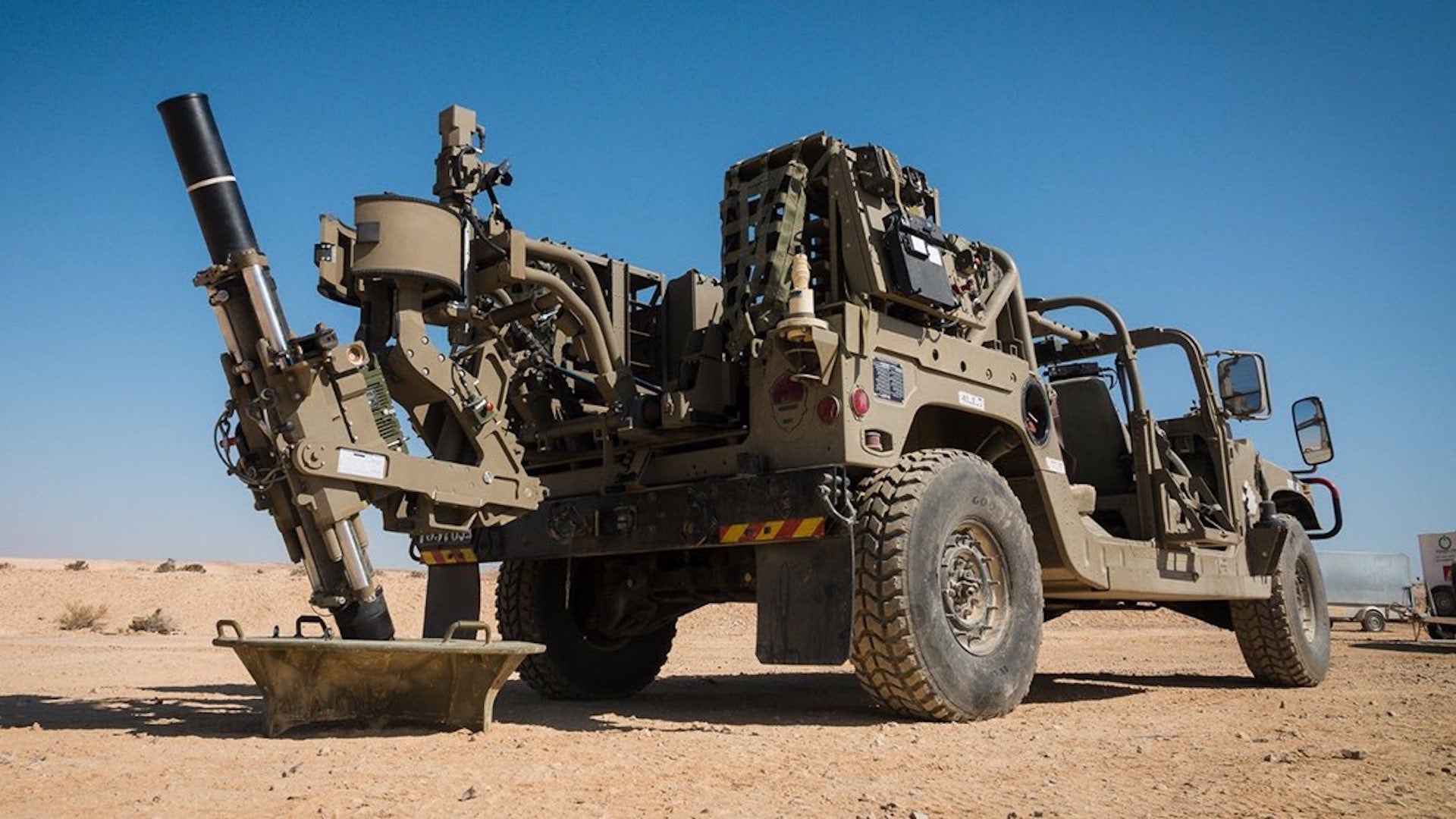
 taskandpurpose.com
taskandpurpose.com
Green Berets are testing a new highly mobile 120mm mortar system
An Army Special Forces group is working on testing and fielding a brand new 120mm mortar system platform for U.S. special operations forces around the world, officials announced on Thursday.The 3rd Special Forces Group (Airborne) has launched a new partnership with Elbit America, a subsidiary of Israel-based Elbit Systems, to “develop, test, and field” a new prototype mortar system platform known as “Sling” that comes mounted on the back of a vehicle, Sgt. 1st Class Zach VanDyke said in a statement.
Originally unveiled in January and designed to integrate with a standard Humvee, Elbit claims the system can deploy within 30-60 seconds and can fire off 16 mortar rounds per minute (with a sustained rate of 3-4 rounds per minute) at an effective firing range of up to 7 km, or 4.3 miles, with M933 High Explosive rounds.

Green Berets are testing a new highly mobile 120mm mortar system
Here comes the boom ...
FJAG
Army.ca Legend
- Reaction score
- 11,385
- Points
- 1,160
Saw that and its an interesting solution.This looks pretty cool...
Green Berets are testing a new highly mobile 120mm mortar system
An Army Special Forces group is working on testing and fielding a brand new 120mm mortar system platform for U.S. special operations forces around the world, officials announced on Thursday.
The 3rd Special Forces Group (Airborne) has launched a new partnership with Elbit America, a subsidiary of Israel-based Elbit Systems, to “develop, test, and field” a new prototype mortar system platform known as “Sling” that comes mounted on the back of a vehicle, Sgt. 1st Class Zach VanDyke said in a statement.
Originally unveiled in January and designed to integrate with a standard Humvee, Elbit claims the system can deploy within 30-60 seconds and can fire off 16 mortar rounds per minute (with a sustained rate of 3-4 rounds per minute) at an effective firing range of up to 7 km, or 4.3 miles, with M933 High Explosive rounds.

Green Berets are testing a new highly mobile 120mm mortar system
Here comes the boom ...taskandpurpose.com
But
We were hauling mortars around in the back of 3/4 ton trucks back in the Fifties and Sixties and they could be into and out of action in less than a minute.
And. You could take them dismounted on airmobile assaults.
So the Elbit system isn't a big deal with the exception of that bit of work it saves the crew in emplacing and tearing down the mortar which is really not a big deal at all.
I'm a firm believer in such things as a 120 mortar under armour in say a Stryker M1129 in the SBCT or an M1064/XM1287 for the ABCT with an extra 81mm as part of their kit to take on dismounted ops. Even better if its an enclosed turret like the AMOS.
US ICBT Infantry battalions still do it the old way. They have four 120mm (plus an 81mm each) mortars each with an HMMWV and trailer (The rifle companies only have 60mm mortars (no vehicles)). It gives you options that the Elbit system doesn't seem to. 120mm Mortar trailer with quick stow kit here.

Mortars are counter fire magnets. A light vehicle but with an armoured cab strikes me as essential. Preferably the mortar should be able to fire from under armour even if the crew is partially exposed while firing. Put the hydraulics into stabilizers that transfer the shock to the ground rather than the wheels. And each detachment should have an arms locker 81mm for dismounted ops.
The Wiesel did that in under 5 tons which isn't much more than what your average HMMWV would be with the Elbit kit attached

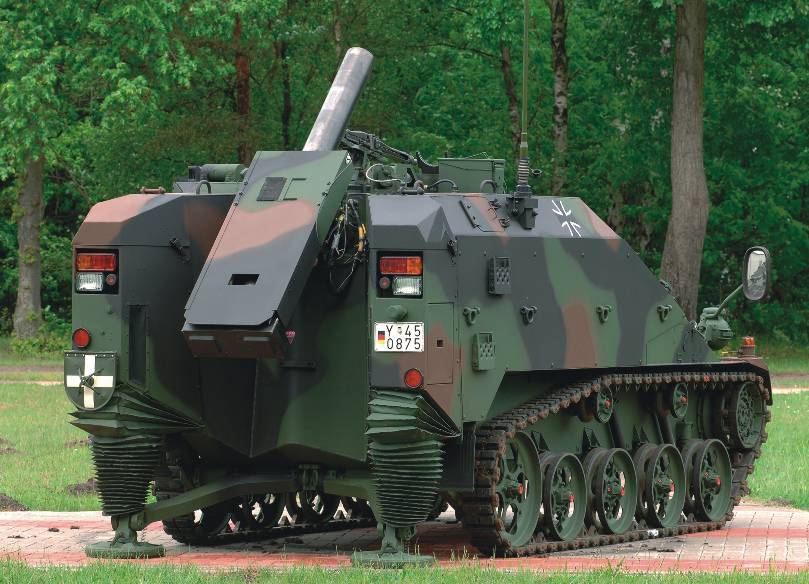
$.02

